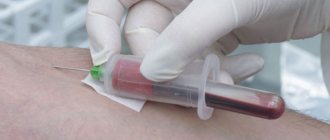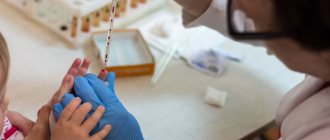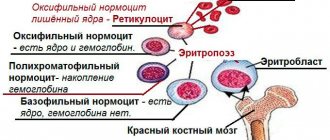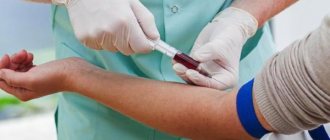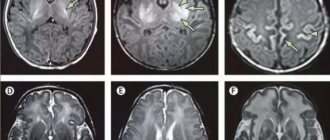Depending on age, the frequency of bowel movements, consistency and color of stool are different. In infants, the frequency of bowel movements can be up to 7-8 times a day and up to 1 time every 2-4 days, and this is the norm. In children of the 2nd year of life, the number of bowel movements is 1-2 times a day. The stool should be well-formed and of soft consistency, the number of bowel movements is determined by the child’s individual rhythm - the baby is healthy and there is no need to worry.
If the baby's stool is liquid or looks like "sheep" feces, it is advisable to consult a pediatrician and examine the child as planned.
The color of the stool may vary, mainly depending on what foods the child eats. But if the baby’s stool has become black and sticky, it may be bleeding (stomach or intestinal); if it has become colorless, it may be a liver or gallbladder disease.
URGENT CARE
Call an ambulance if:
- The child's stool has become black and sticky
- a child's stool is profusely mixed with scarlet blood (bleeding from the lower gastrointestinal tract, mainly the large intestine)
THE DOCTOR'S CONSULTATION
Contact your pediatrician if:
- the skin and mucous membranes turn yellow and the stool is discolored
- the child's stool is large, greasy and has an unpleasant odor (a sign of poor digestion)
ATTENTION!
If the stool is copious, greasy, or foul-smelling, this is a sign of poor digestion. A doctor's consultation is required .
| ASK YOURSELF A QUESTION | POSSIBLE REASON | WHAT TO DO |
| The general condition is good, there is a tendency to constipation, the child has pain when defecating, and a few minutes later there is blood on the toilet paper and a little in the stool | Anal fissure | Consultation with a pediatrician for examination and examination |
| Change in stool after taking medications (antibiotics), becoming more liquid | Side effects of drugs | Consultation with a doctor to discontinue the medication or reduce the dose and course of treatment |
| The child feels well but has dark-colored stools (is taking iron supplements, or has eaten blueberries or dark green vegetables) | Effect of medications or food on stool | The baby is fine, no need to worry |
| The baby's stools have become clayey and light in color, his urine has darkened, his skin has a yellowish tint, and his sclera (the whites of his eyes) have turned yellow. | Viral hepatitis (older children) Congenital liver disease or biliary atresia (newborns) | Call your pediatrician immediately, for examination and treatment, the child may be hospitalized. Before the doctor arrives, keep the baby calm. |
| The stool is faintly colored, smells unpleasant, is greasy and profuse | Insufficient digestion | Consultation with a pediatrician (or gastroenterologist ) for examination and treatment prescription |
| An increase in temperature, a violation of the general condition, an admixture of dark burgundy or scarlet blood in the stool | Inflammatory diseases of the gastrointestinal tract, bleeding from different parts of the intestine | Call emergency services immediately ; hospitalization for examination and treatment is possible. |
| Stools resemble coffee grounds or are black and sticky | Bleeding from the upper gastrointestinal tract (esophagus or stomach), called melena | Call emergency services immediately ; hospitalization for examination and treatment is possible. |
FOR INFORMATION
Stool color and consistency
The color and consistency of your child's stool may change from time to time - this is normal. However, traces of fresh blood or black, sticky stools may be signs of bleeding and require urgent evaluation. The sudden appearance of loose stools, with or without mucus, indicates diarrhea. If the stool is copious, greasy, smells bad, and is faintly colored, these are signs of poor digestion of food. In all these cases, an examination by a pediatrician is required. If your child's stool is light, clay-colored and his urine has become dark, viral hepatitis is possible - call your pediatrician immediately .
Minor changes in stool color are related to diet. In breastfed children, the stool is soft, almost liquid, reminiscent of light mustard. It may contain particles that look like seeds. With artificial feeding, the stool is yellowish-brown or yellow, denser, but still no denser than putty. If the stool is very hard and dry, this may be due to a lack of fluid or excess fluid loss, for example, with sweat due to an increase in temperature, etc. If the child has eaten a large portion of vegetables or other difficult-to-digest foods, digestion may slow down and the stool may be very dark colors. Beetroot or red-colored foods may cause your stool to become reddish (for the same reason, your urine may turn pink).
The stool turns blue, purple, or another shade if the child tastes crayons. In this case, as soon as the colored substance is released from the intestines, the stool returns to its normal color. If the child's condition worsens, call the pediatrician immediately - poisoning is possible.
I will try to describe a typical baby with allergic proctocolitis.
Usually this is a well-developed, well-fed baby with excellent health, in whom, from the age of 2-3 months, parents began to notice a slight increase in stool (may or not) and streaks of scarlet blood in the stool.
Often there is also a lot of mucus in the stool.
Typically, with typical proctocolitis there is no obvious colic, but there may be restlessness when passing stool
Allergic proctocolitis can develop both in a breastfed and artificially fed child.
In a general stool analysis, you can find a large number of leukocytes in the stool (although this sign is nonspecific), and there may be a completely normal analysis.
In a general blood test, hemoglobin may be slightly reduced and the number of eosinophils may be increased, but everything may be fine.
It is with this picture that one should think about allergic proctocolitis.
Treatment of constipation involves achieving the following goals:
1. Normalization of stool consistency (soft, painless stools)
2. Regularity of bowel movements (prevention of re-accumulation of feces)
Treatment of constipation is a sequential, complex, individual process and consists of several stages:
- child and parent education
- correcting nutrition and drinking regime
- elimination of existing coprostasis using medications
- maintenance therapy
It is necessary to exclude factors that provoke and contribute to constipation (normalization of motor and eating habits, stopping taking medications that can cause constipation, identifying a food allergen, excluding or confirming a neuromuscular disease, celiac disease, etc.).
Lifestyle normalization includes:
- development of a conditioned reflex
- active lifestyle
- gymnastics
- training in light abdominal massage skills
- for small children - laying on the stomach, bending the legs towards the stomach.
Education is the first step in the treatment of functional constipation. It must be remembered that episodes of stool loss and encopresis (fecal incontinence) are not voluntary and should not be blamed on the child, who may already be scared and disoriented. In some cases, when the family situation is difficult, the help of a family psychologist may be needed.
It is important to understand that treatment for functional constipation can be lengthy, is based on trust in the doctor, partnership and requires patience. Modern laxatives, approved for children, will not make the intestines “lazy”, will not cause “addiction”, they enter the bloodstream in minimal quantities or are not absorbed at all and are safe for long-term use.
Correcting the behavior of a child with constipation is based on developing a toilet routine in order to achieve regular bowel movements. Defecation should be done at the same time every time. The urge to defecate is based on the gastrocecal reflex, which manifests itself in the morning 1 hour after eating. A child with constipation needs to spend 3-10 minutes on the toilet (depending on age). The child should be seated on the potty or offered to go to the toilet after each meal.
A prerequisite for effective defecation is to provide a good foot rest (a low bench on which the child can place his feet), which helps to increase intra-abdominal pressure.
If defecation is unsuccessful, the child should under no circumstances be punished and vice versa. The daily frequency of bowel movements can be noted in a diary, which can be reviewed at a routine visit to the doctor.
Treatment of constipation must begin with lifestyle changes, which include correction of diet, drinking regimen and physical activity.
Which allergen to exclude?
The most common allergen is cow's milk protein.
Cow's milk is the basis for the preparation of standard milk formulas for babies, but dairy products can also be present in the diet of a nursing mother, later penetrating into breast milk.
By the way: Back in 1921 (almost a hundred years ago!) the possibility of allergens from the mother’s diet entering breast milk was proven.
There are about 25 different allergen proteins in cow's milk, some of which are found in the milk of other animals - goats, sheep, and so on.
The most significant allergens are beta-lactoglobulin and casein.
Therefore, to check the breastfeeding of children, the mother switches to a dairy-free diet, and bottle-fed children are transferred to a special formula, where milk protein is broken down to the smallest fragments (deep hydrolysates) or absent (a solution of amino acids instead).
Amino acid mixtures are the most non-allergenic and safe even for severe allergy sufferers, but are much more expensive than hydrolysates.
During the trial diet, mothers often exclude beef/veal for a while - 10% of children have a chance of cross-allergy.
Expert opinion
Anorectal fissure in a child is a relatively favorable condition compared to adults. If you seek specialized help in a timely manner, the problem can be eliminated conservatively in a short time. Due to the good ability to restore the mucous membrane in children, therapy can take only 4-5 days. The main thing is not to ignore the first signs of the disease. Otherwise, an acute crack becomes chronic, becomes a cause of daily discomfort for the patient, and requires surgical intervention.
What to do if a trial diet excluding cow's milk protein does not work?
- if the child is breastfed, reconsider the mother’s diet (what if hidden milk protein still appears) or try to exclude other, rarer allergens - soy, chicken eggs, wheat
- if the child is on hydrolyzate, switch to an amino acid mixture
Please note - soy is also a common allergen in itself (up to 0.5% of the population), and in people with an existing allergy to milk protein, the frequency of cross-allergy to soy is from 15% to 50%.
We also take into account other reasons for the periodic appearance of blood in the stool:
- Dermatitis around the anus
- Fissure of the anus - usually in the presence of dense stool in a baby, usually on artificial feeding. A visible fissure in the anus in the presence of soft stool does not exclude allergic proctocolitis.
- Infections. Usually, if a child has such classic intestinal infections as salmonellosis or dysentery, the child has obvious signs of intoxication, and with campylobacteriosis, the baby’s well-being may be relatively good.
- Blood clotting disorders (very rare, usually there are other manifestations of bleeding)
Causes of anal fissure
The pathogenetic basis for the development of anal fissure in children is a violation of the integrity of the anal mucosa. The cause of such a defect may be:
- Tear of tissue due to the passage of too thick stool.
- Incorrect placement of cleansing enemas or gas exhaust tubes when the mucous membrane is injured by hard elements of medical products.
- Incorrectly performed surgical interventions in the anorectal area.
It is important to understand that a violation of the integrity of the mucous membrane in the described situations does not always occur. The risk of developing the problem is increased by provoking factors:
- Genetic predisposition or the presence of congenital malformations of the anorectal region or the entire gastrointestinal tract (GIT).
- Chronic intestinal infections accompanied by diarrhea. In such cases, the mucous membrane becomes thinner and becomes more vulnerable to the mechanical impact of thick feces.
The situation is further aggravated by the presence of a local inflammatory process.
- Proctitis and other diseases of the rectum, which directly reduce tissue resistance.
- Metabolic disorders. Diabetes mellitus and pathology of absorption of individual food components create conditions for defecation disorders and changes in the normal architecture of tissues.
- Traumatic injuries to the anorectal area - falls, blows, scratching of the anal area against the background of helminthic infestation.
What if the complaints disappeared during the diet, but doubts remained?
It is possible to reintroduce the allergen protein: the previous complaints have reappeared - doubts have been resolved.
Important: this should not be done in case of acute and severe allergic conditions; anaphylactic shock is possible!
But proctocolitis is not an acute, not serious condition, so the experiment is possible.
The prognosis for non-IgE conditions is usually good.
Complaints will disappear even if you do nothing at all... but it’s better not to do that!
Often, when discussing complaints from a baby, parents remember that older children also had blood in the stool in the first months of life, but then disappeared on their own. With hindsight we understand that most likely they also had allergic proctocolitis.
In most children with proctocolitis, complaints disappear before the age of one year, with FPE between the ages of 1 and 3 years, with FPIES between the ages of 1 and 5 years.
Very rarely, allergic proctocolitis persists into older age or occurs for the first time in older children or adults.
In these cases, it is very difficult to exclude a certain trigger food product; drug treatment is often required - corticosteroids, aminosalicylates. The range of conditions for a differential diagnosis by a doctor is also different.
7, total, today
First aid for bloody diarrhea
What to do if a child has bloody diarrhea? First of all, you need to call a doctor or ambulance. Before their arrival, to alleviate the condition and prevent dehydration, older children should alternately be given a little sweet tea and salted water every 5-10 minutes. Infants need to be put to the breast more often. It is also important to limit your food intake until further instructions from your doctor.
* Among products based on Loperamide. Based on sales in money for February 2021 - January 2021, according to IQVIA (from English IQVIA).
Why do newborns develop jaundice so often?
The frequent occurrence of jaundice in newborns is due to the following reasons:
- the newborn has a large number of red blood cells in the blood, which helps prevent the development of hypoxia;
- The structure of hemoglobin in a fetus differs from the structure of hemoglobin in an already born baby and an adult. Fetal hemoglobin is called fetal hemoglobin. It has a greater affinity for oxygen and less resistance to changes in environmental conditions. Immediately after birth, there is an intensive breakdown of fetal hemoglobin and its replacement with “ordinary” hemoglobin. This sharply increases the amount of free hemoglobin, and then bilirubin in the blood;
- characteristic of a newborn, the immaturity of liver enzymes involved in the conversion of free bilirubin into bound bilirubin;
- lack of intestinal microflora in the newborn, which also takes part in the removal of bilirubin from the body.
Due to these features, normal bilirubin in a newborn is several times higher than in adults. In children who, during intrauterine development or childbirth, encountered certain traumatic factors (prematurity, fetal hypoxia, intrauterine infection, bleeding), the risk of jaundice increases.
Diagnosis of anal fissure
Anal fissure is diagnosed by a pediatric proctologist or surgeon.
Even when parents first contact a doctor, a specialist may suspect the presence of this disease. The doctor pays attention to the child’s characteristic complaints, the influence of provoking factors, and the history of the development of the pathological process. A digital rectal examination is required to make a definitive diagnosis. However, in order not to cause psycho-emotional discomfort in the presence of severe pain, the doctor may first limit himself to a simple examination of the anal area. Sometimes the defect can be identified immediately.
If a rectal examination is not performed immediately, it will be postponed to the next visit. The fact is that anal fissures are often a consequence of other proctological diseases, which may not be diagnosed without a full examination. This means that the pathology of the rectum will steadily progress.
To comprehensively assess the patient’s condition, the following tests are performed:
- General blood and urine analysis. Allows you to identify concomitant diseases, primarily anemia, inflammation.
- Coprogram is a microscopic analysis of feces, which is especially important if dysfunction of other parts of the gastrointestinal tract is suspected.
- Blood chemistry. Detects metabolic changes in the body.
- Ultrasound of the abdominal organs. Detects abnormalities in the development of internal organs.
If a concomitant pathology is identified, its treatment is carried out in parallel, which helps to avoid recurrence of the anal fissure.
Why does newborns' skin turn yellow?
The most numerous blood cells are erythrocytes. Their main function is to transport oxygen from the lungs to tissues and organs through the bloodstream. The protein that is part of the red blood cell and holds the oxygen molecule is called hemoglobin.
The average lifespan of red blood cells is 3-4 months. The process of disintegration of old blood cells and the formation of new ones occurs in the body constantly and continuously. As a result of the breakdown of red blood cells, hemoglobin is released from the cells and is transformed into bilirubin.
Free (indirect) bilirubin enters the liver cells through the bloodstream. There, with the help of special enzymes, it is converted into so-called bound (direct) bilirubin. Through the system of bile ducts, as part of bile, it enters the intestines and partially back into the blood, and is then excreted from the body along with feces and urine, coloring them a characteristic yellow color. Failure at any of the above stages causes the accumulation of excess bilirubin in the blood.
Since bilirubin is highly soluble in adipose tissue, its excess quickly and easily accumulates in the subcutaneous fat, causing staining of the skin and mucous membranes. For the same reason, a pronounced excess of bilirubin can accumulate in the tissues of the nervous system, causing symptoms of its damage.


